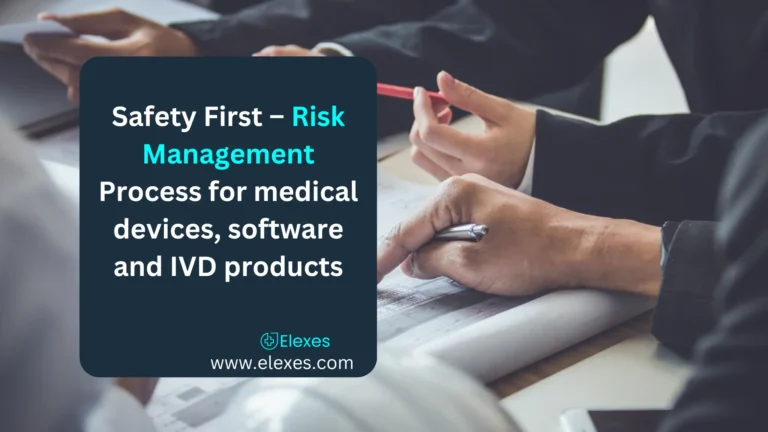Risk Management for Medical Devices: Ensuring Safety & Compliance
As we know a medical device is a device intended for medical purposes. Such devices have numerous applications in the life of humans as well as animals. Some of it is the diagnosis, treatment, mitigation, prevention, and monitoring of diseases. As medical device usage can directly impact the health and life of human beings, it is crucial to ensure these devices’ safety and efficiency.
Manufacturers of medical devices are thus responsible for designing and developing risk-free and efficient medical devices, IVD and software products. The process of risk management for medical devices, software, and IVD products helps identify, evaluate, mitigate and monitor the risk right from the design of a product throughout its lifetime. Risk management is an elaborate process that requires dedicated personnel and a streamlined process.
What is a Risk?
Risk may be a consolidation of the probability of eventuality of harm and the severity of that harm:
- Harm is the injury or damage to the health of individuals or damage to the property and environment
- Severity is the measure of the possible reverberations of a hazard
- Hazard could be a potential source of harm
What is a Risk Management process?
Risk management could be a systematic implementation of the procedures, management policies, and practices for the tasks of analyzing, evaluating, controlling, and monitoring risk throughout a product’s lifecycle. The risk management process could be a continuous process, a manufacturer should implement, document, and maintain for:
- Risk Analysis – identifying hazards and unsafe situations associated with a medical device, IVD, combination products, and software as a medical device (SaMD)
- Risk Evaluation – estimating and evaluating the related risks against the acceptability criteria
- Risk Control – controlling the identified risks
- Monitoring – evaluating the potency of the risk control measures
The flowchart below accounts for the steps in a risk management process. The 6 major elements of a risk management process are:
- Risk analysis
- Risk evaluation
- Risk control
- Evaluation of overall residual risk
- Risk management review
- Production and post-production activities
Risk assessment can be considered as the consolidation of Risk analysis and Risk evaluation.

What is Risk Analysis?
Risk Analysis is the structured use of available information to identify the potential source of harm and to estimate the risk.
Risk analysis shall include the following:
- The intended use of the device and reasonably predictable misuse
- Identification of attributes related to safety
- Identification of hazards and hazardous situations
- Risk estimation
Risk analysis results and the documentation of the conduct of the analysis shall include the following:
- Identification and description of the analyzed medical device
- Identification of the person(s) and organization who carried out the risk analysis
- Scope and date of the risk analysis
Risk Estimation in Risk Analysis:
Risk estimation is the process used to assign values to the probability of occurrence of harm and the severity of that harm.
Information or data for estimating risks can be obtained from:
- The published standards
- Scientific or technical investigations
- Field data from similar medical devices already in use,
- Publicly available reports of incidents
- Usability tests employing intended users
- Clinical evidence
- Results of relevant investigations or simulations
- Expert opinion
- External quality assessment schemes for in vitro diagnostic medical devices
What is Risk Evaluation?
The process of risk evaluation comprises determining whether a risk is acceptable by comparing the anticipated risk to predetermined risk criteria.
If the risk is deemed acceptable, the rules outlined in the risk control activities do not have to be followed, and the anticipated risk should be handled as residual risk.
If the risk is not acceptable, risk control procedures must be followed in order to lessen the risk.
What is Risk Assessment?
Risk assessment is the entire procedure that includes a risk management processes risk analysis and risk evaluation. This stage of the risk management process is the beginning.
The method of determining a medical device’s risk is represented by the flowchart below:

The table below is an example of a risk assessment matrix which is an important aid to analyze the severity levels with the likelihood of the identified risks and thus evaluate their acceptability. Every risk associated with the device is assessed with the help of such kinds of matrices and necessary steps are taken to control or mitigate the risks.

Importance of Risk assessment and when to start?
The Risk assessment process is an important ingredient for the safety and performance of your medical device. If a hazard is identified, risk assessment helps determine whether it is an acceptable one or if it contributes to the change in the design and hence the development of the device. Therefore, it is always necessary to start the risk assessment from the early stages of the design process and should continue throughout the lifetime of the device.
If you are a medical device firm wanting to do a risk assessment of your device, you must consider what the appropriate assessment criteria are, and how you will implement them appropriately.
Elexes is a well-known name in regulatory and quality compliance for medical device, software, and IVD manufacturers and has been involved in performing preliminary and at later stages risk assessment so the manufacturers develop products that can be approved by the regulatory bodies with ease with minimal back and forth.
For all your concerns related to the Risk assessment, please contact us at jennifer@elexes.com.
elexes #medicaldevices #healthcare #regulatory #quality #riskassessment #software #ivd





















